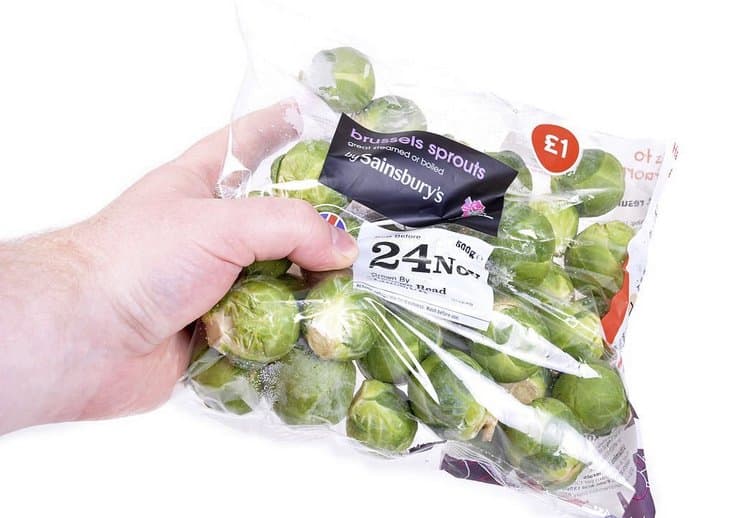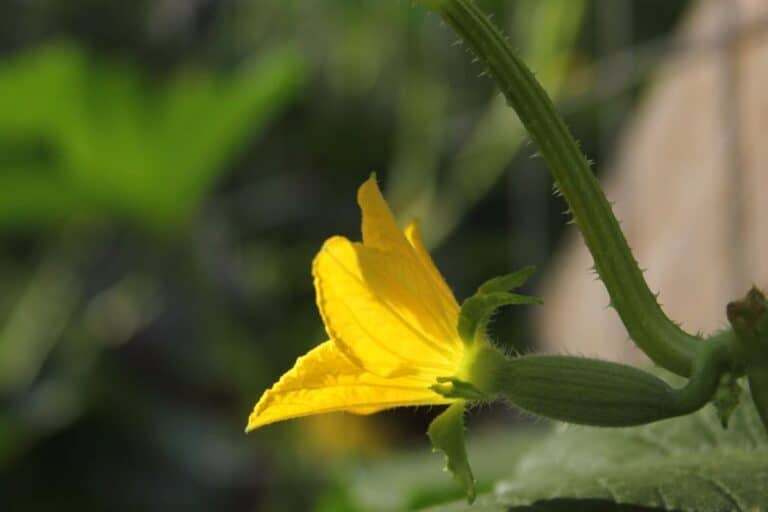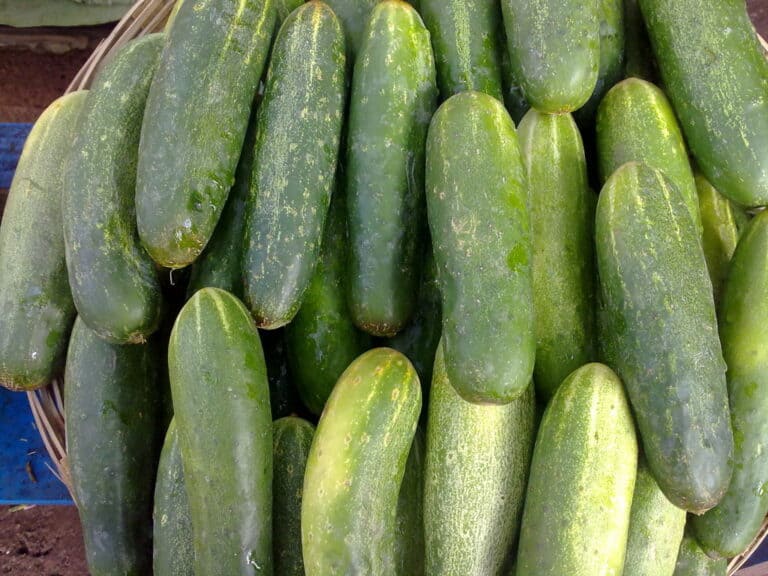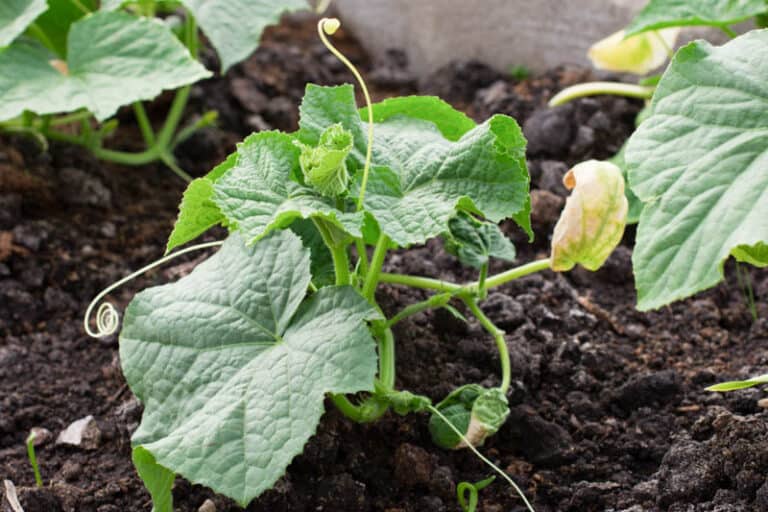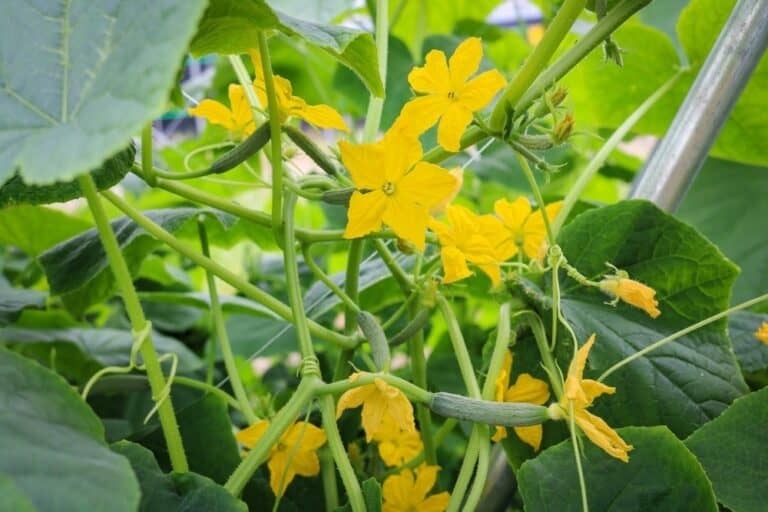Yellowing Cucumber Leaves: Treatment and Prevention for a Healthy Plant
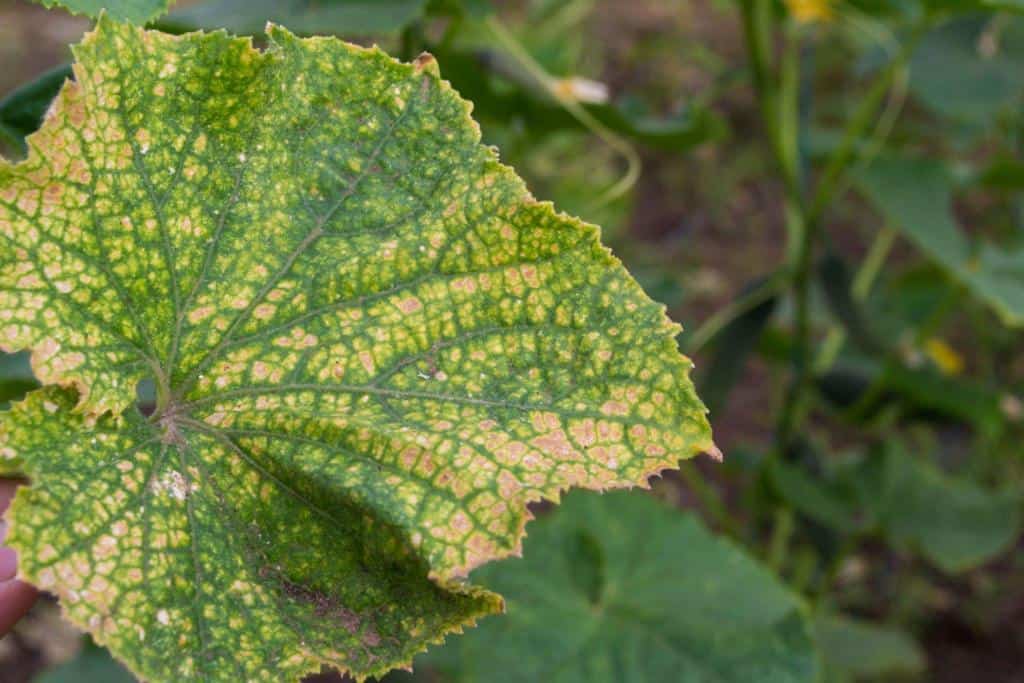
Are your cucumber leaves yellowing despite having seemingly ideal growing conditions? Yellowing cucumber leaves can be a frustrating problem for growers, but it’s important to understand that it’s a symptom of a larger issue.
Whether it’s a pest problem, a fungal or bacterial infection, or a lack of nutrients, the key to treating and preventing leaves from turning yellow is to find out what’s causing it.
In this blog post, we’ll explore the common causes of cucumber plant leaves are turning yellow and provide practical tips for treatment and prevention. So, whether you’re a seasoned gardener or a newbie, read on to learn how to keep your cucumber plants healthy and green.
What Is the Cause of Yellowing Cucumber Leaves?
There are many things that can make cucumber leaves turn yellow, such as a lack of nutrients, pests, diseases, and environmental factors.
1. Lack of Nutrients
One reason why leaves might turn yellow is a lack of nitrogen, which is a nutrient that plants need to grow and develop. Nitrogen deficiency can lead to pale or yellow leaves as well as stunted growth.
Other nutrient deficiencies, such as a lack of potassium or phosphorus, can also cause yellowing leaves.
2. Pests
Another possible cause of yellowing cucumber leaves is pest infestation. Common cucumber pests include aphids, whiteflies, and spider mites, all of which can suck the sap from the leaves and cause them to turn yellow.
In addition to making the leaves turn yellow, these pests can also make the leaves bend or curl, change color, or get yellow spots.
3. Disease
Disease can also cause yellowing cucumber leaves. Cucumber mosaic virus and powdery mildew are two common diseases that can lead to yellowing leaves.
The cucumber mosaic virus makes the leaves look mottled and messed up, and powdery mildew makes the leaves get a white, powdery coating. Both of these diseases can also cause stunted growth and reduced yields.
4. Environmental
Lastly, things in the environment like soil that is too dry or too wet, too much or too little light, and temperature can also cause leaves to turn yellow. Improper irrigation or poor drainage can lead to waterlogged soil, which can cause the leaves to yellow and eventually die.
Treatment for Cucumber Leaves From Turning Yellow
1. Maximise Sunlight
To keep the leaves of cucumbers from turning yellow, give the plant as much sunlight as possible. This can be done by planting them in a location that receives at least 6–8 hours of direct sunlight per day.
A south-facing slope or a raised bed is ideal, as it will allow more light to reach the lower parts of the plant where leaves may otherwise become shaded out by taller foliage.
2. Avoid Overwatering
It is important to monitor the moisture level of the soil. Cucumbers prefer well-drained soil and do not tolerate standing water. How often to water cucumber plants? It’s better to water the plants deeply and infrequently rather than watering them frequently but only a little bit each time.
It’s a good idea to wait until the top inch of soil is completely dry before watering it again. Make sure the soil is well-drained and not compacted so that the water can drain away easily. Putting mulch around the plants’ bases can also help keep water in the soil and keep it from getting too wet.
One to two inches of water, including rain, are required by cucumber plants each week.
3. Nutrients In The Soil
To prevent cucumber leaves from turning yellow due to a lack of nutrients in the soil, make sure the plants are getting the right balance of nutrients.
Cucumbers grow best in soil with a pH of 6-7. They also need to be fertilized regularly with a balanced fertilizer that has nitrogen, phosphorus, and potassium.
You want to make sure that the soil is rich in organic matter, which can help provide the plants with the necessary nutrients.
Signs of nutrient deficiencies can include yellowing leaves, poor growth, and poor fruit production. If you think you might have a deficiency, you can also test the soil to find out which nutrient is missing and then fix the soil.
Cucumber plants are heavy feeders, so regular fertilization is important to keep the plants healthy and prevent yellowing leaves.
A professional horticulturist or plant pathologist can also help you figure out what disease it is and how to treat it.
Prevention for Cucumber Leaves From Turning Yellow
1. Use Resistant Varieties of Cucumber
Using resistant varieties is one of the best ways to avoid and treat cucumber diseases. Varieties that are resistant are those that have been bred or chosen to be less likely to get certain diseases. This can greatly reduce the risk of infection and the need for chemical treatments.
For example, there are varieties of cucumbers that have been developed to be resistant to Fusarium wilt, a fungal disease that can cause wilting and leaves turning yellow. Growers can greatly reduce the chance of getting sick and the need for fungicides by planting these resistant varieties.
In the same way, there are varieties that are resistant to powdery mildew and downy mildew, which are both common fungi that can cause the leaves to turn yellow.
The use of resistant varieties can also help reduce the spread of disease in the field. When disease-resistant varieties are planted next to susceptible varieties, the disease can spread more easily. However, if only disease-resistant varieties are planted, the disease is less likely to spread. This can help protect the whole crop and keep chemicals from having to be used everywhere.
Using resistant varieties can also help lower the chance that pesticides will stop working. Growers who use a lot of chemicals to treat pests and diseases may develop resistance, making the chemicals less effective. Growers can cut down on their use of chemicals and slow the spread of pesticide resistance by choosing resistant varieties.
2. Use of Appropriate Pesticides and Fungicides
Pesticides and fungicides can help keep cucumbers from getting sick and treat them when they do. These chemical treatments can help control pests and pathogens that can cause damage to the plants.
Use them correctly and wisely to make sure they don’t hurt the environment or people’s health too much. Only select products that are specifically labeled for use on cucumbers and for the specific disease or pest that you are trying to control.
Read and follow the instructions on the label, including safety precautions and application rates. Using pesticides and fungicides at the wrong time or at higher rates than recommended can be harmful to beneficial insects, pollinators, and other non-target organisms, as well as the environment.
Another important aspect to consider is the frequency and timing of applications. Preventive sprays can help reduce the risk of infection, but they should be used only when necessary and at the appropriate time, based on the life cycle of the pest or pathogen.
For example, if a disease is spread by an insect vector, it may be more effective to spray when the insect is most active rather than when the disease is already present.
Don’t forget that using pesticides and fungicides doesn’t replace other ways to prevent problems, like using resistant varieties, giving the plants the right care and maintenance, and rotating crops.
Integrated pest management, which uses more than one method to get rid of pests, is more effective and lasts longer.
3. Crop Rotation To Prevent Buildup of Pathogens in the Soil
Crop rotation is an important way to keep cucumber plants healthy and stop pathogens from building up in the soil. It means growing different crops in a field or area in a planned order instead of planting the same crop in the same place every year.
This can help reduce the buildup of pathogens in the soil, as well as pests and weeds that can harm the plants.
The basic principle of crop rotation is to avoid planting the same crop family in the same location for several years in a row. For example, cucumbers belong to the cucurbit family, which also includes other plants such as squash, melons, and pumpkins.
By rotating cucumbers with other crops that are not in the cucurbit family, such as tomatoes, corn, or beans, growers can reduce the risk of disease and pests that are specific to the cucurbit family.
Crop rotation can improve soil health, by providing different types of plants with different nutrients and organic matter. This can help reduce the need for chemical fertilizers and improve the overall fertility of the soil.
It can also help reduce the need for pesticides and fungicides by reducing the pressure from pests and pathogens, which can lead to more sustainable and environmentally friendly farming practices.
Identification of Specific Diseases
- Downy Mildew. Downy mildew is a fungal disease that is characterized by yellow spots or brown spots on the upper surface of the leaves, and a white, downy growth on the undersides. It is caused by the fungus called Pseudoperonospora cubensis.
- Powdery Mildew: Powdery mildew is another fungal disease that is characterized by a white or gray powdery growth on the leaves, stems, and fruit at the infected plants. The fungus that causes powdery mildew is called Erysiphe cichoracearum.
- Fusarium Wilt. Fusarium wilt is a fungal disease that causes wilting and yellowing of the leaves, starting on one side of the plant. Over time, the entire plant may wilt and die. The fungus that causes Fusarium wilt is called Fusarium oxysporum.
- Cucumber Mosaic Virus (CMV). Cucumber Mosaic Virus is a viral disease that causes yellowing, mottling and leaf distortion. The virus is spread by aphids and other insect vectors that live on the underside of leaves.
- Bacterial Wilt. Ralstonia solanacearum is the bacterium that causes bacterial wilt. Symptoms include wilting, yellowing and browning of leaves, and the plant will wilt and die in a short period of time. It is spread by the cucumber beetle.
| Please remember that a yellowing leaf could be caused by a number of different things, and a single yellow leaf might not always mean a disease. For a correct diagnosis and treatment, the suspected infected plants must be carefully examined, including its leaves, stem, roots, and the environment around it. |
Should You Cut off Yellow Cucumber Leaves?
In some cases, cutting off yellow leaves may be beneficial. For example, if the leaves are infected with a fungal or bacterial disease, cutting them off can help reduce the spread of the disease and protect the rest of the plant.
Similarly, if the yellowing is caused by pests, such as aphids or spider mites, cutting off the affected leaves can help remove the pests and prevent them from spreading to other parts of the plant.
However, in other cases, cutting off yellow leaves may not be necessary or even harmful. For example, if the yellowing is caused by a lack of a nutrient, like nitrogen or potassium, cutting off the leaves won’t fix the problem and may hurt the plant even more.
Also, if the yellowing is caused by the environment, like a lack of water or sunlight, cutting off the leaves won’t fix the problem and may even make it harder for the plant to make fruit. So in this case, it is better to cut the infected plants all together.
Another important aspect to consider is the overall health of the plant. If the plant is healthy and producing fruit, cutting off a few yellow leaves may not have a significant impact. However, if the plant is already struggling and has a significant number of yellow leaves, cutting them off may cause additional stress and further decline.
Conclusion
There are many things that can cause the leaves on a cucumber plant to turn yellow. To save the plants, it is important to find out what the exact problem is. A local extension agent or a professional agronomist might be able to help you figure out what’s wrong and how to fix it.
A key way to prevent and treat cucumber diseases is to use varieties that are resistant to them. Growers can greatly reduce the chance of getting sick and the need for chemical treatments by planting varieties that have been bred or chosen to be resistant to certain diseases. It is a sustainable and effective way to protect the crop and maintain a healthy harvest.
Whether or not to cut off yellow cucumber leaves depends on the specific situation and the overall health of the plant. If the yellowing is caused by a disease or pests, cutting off the affected leaves can help reduce the spread of the problem and protect the rest of the plant.
But if the yellowing is caused by a lack of nutrients or by things in the environment, cutting off the leaves won’t fix the problem and may hurt the plant even more. It’s important to figure out what’s wrong and take the right steps, taking into account the plant’s overall health.

